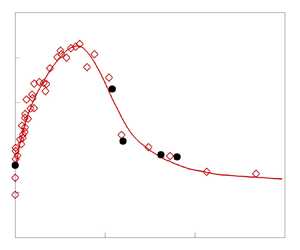In this work, the stability and transition to turbulence over blunt flat plates with different leading-edge radii are investigated computationally. The benchmark experimental work for comparative studies is conducted by Borovoy et al. (AIAA J., vol. 60, 2022, pp. 497–507). The freestream Mach number is 5, the unit Reynolds number is  $6\times 10^7$ m
$6\times 10^7$ m $^{-1}$, and the maximum nose-tip radius 3 mm exceeds the experimental reversal value. High-resolution numerical simulation and stability analysis are performed. Three-dimensional broadband perturbation is added on the far field boundary to initiate the transition. The highlight of this work is that the complete physical process is considered, including the three-dimensional receptivity, linear and nonlinear instabilities, and transition. The experimental reversal phenomenon is reproduced favourably in the numerical simulation for the first time. Linear stability analysis shows that unstable first and second modes are absent in the blunt-plate flows owing to the presence of the entropy layer, although these modes are evident in the sharp-leading-edge case. Therefore, the transition on the blunt plate is due to non-modal instabilities. Numerical results for all the blunt-plate cases reveal the formation of streamwise streaky structures downstream of the nose (stage I) and then the presence of intermittent turbulent spots in the transitional region (stage II). In stage I, a preferential spanwise wavelength approximately 0.9 mm is selected for all the nose-tip radii, and low-frequency components are dominant. In stage II, high-frequency secondary instabilities appear to grow, which participate in the eventual breakdown. By contrast, leading-edge streaks are not remarkable in the sharp-leading-edge case, where transition is induced by oblique first and Mack second modes. The transition reversal beyond the critical nose-tip radius arises from an increasing magnitude of the streaky response in the early stage, while the transition mechanism stays similar qualitatively.
$^{-1}$, and the maximum nose-tip radius 3 mm exceeds the experimental reversal value. High-resolution numerical simulation and stability analysis are performed. Three-dimensional broadband perturbation is added on the far field boundary to initiate the transition. The highlight of this work is that the complete physical process is considered, including the three-dimensional receptivity, linear and nonlinear instabilities, and transition. The experimental reversal phenomenon is reproduced favourably in the numerical simulation for the first time. Linear stability analysis shows that unstable first and second modes are absent in the blunt-plate flows owing to the presence of the entropy layer, although these modes are evident in the sharp-leading-edge case. Therefore, the transition on the blunt plate is due to non-modal instabilities. Numerical results for all the blunt-plate cases reveal the formation of streamwise streaky structures downstream of the nose (stage I) and then the presence of intermittent turbulent spots in the transitional region (stage II). In stage I, a preferential spanwise wavelength approximately 0.9 mm is selected for all the nose-tip radii, and low-frequency components are dominant. In stage II, high-frequency secondary instabilities appear to grow, which participate in the eventual breakdown. By contrast, leading-edge streaks are not remarkable in the sharp-leading-edge case, where transition is induced by oblique first and Mack second modes. The transition reversal beyond the critical nose-tip radius arises from an increasing magnitude of the streaky response in the early stage, while the transition mechanism stays similar qualitatively.








